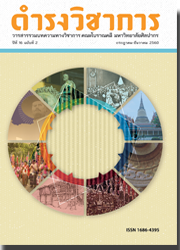Evolution of Buddhist Cloisters After the 19th Century in the Chao Phraya River Basin
Keywords:
Cloisters, EvolutionAbstract
Evolution of Buddhist Cloisters After the 19th Century in the Chao Phraya River Basin
The cloister is the continuous structural enclosure of a presidential building which has its origins in Khmer culture. Its influence has been observed in the monasteries in the Phraya River basin from the early Ayutthaya period onwards. However, the cloisters of the monasteries in the Chao Phraya River Valley are different from those in Khmer culture as listed:
1. In Khmer culture, the cloisters in notable temples usually consist of multiple layers. On the contrary, in the culture of Chao Phraya River Valley during the Ayutthaya period, the cloisters are found as a single enclosure of the principal monasteries of the city (Phra Nakorn).
2. In Khmer culture, the inside walls of the cloisters are decorated with bas relief carvings, the most popular themes during the 18th Buddhist century were the Buddha images, whereas the cloisters in the Chao Phraya River basin are adorned with Buddhist statues.
Due to the fact that the cloisters in the Ayutthaya period are found in the monasteries considered as the main temples of Phra Nakhon, the evolution of the cloisters in this period is not as developed as the ones in the Rattanakosin period where the development has reached its highest point as found on the top floor of the Phra Pathom Chedi Temple.
References
กรมศิลปากร, 2529. จารึกในประเทศไทย เล่ม 4. กรุงเทพฯ: กรมศิลปากร.
กรมศิลปากร, 2533. พระราชพงศาวดาร กรุงศรีอยุธยา ฉบับพระจักรพรรดิพงศ์ (จาด) เล่ม 2. กรุงเทพฯ: องค์การค้าของคุรุสภา.
กรมศิลปากร, 2550. ศัพทานุกรมโบราณคดี. กรุงเทพฯ: กรมศิลปากร.
เจ้าพระยาทิพากรวงศ์ (ขํา บุนนาค), 2507. พระราชพงศาวดารกรุงรัตนโกสินทร์ รัชกาลที่ 4. กรุงเทพฯ: กรมศิลปากร. พลโท บัญญัติ เทพหัสดิน ณ อยุธยา พิมพ์เป็นอนุสรณ์ในงานฌาปนกิจ นางอนงค์ เฑียรฆราษ.
ปติสร เพ็ญสุต, 2555. ศิลปกรรมและสถาปัตยกรรมในเขตพุทธาวาส วัดมหาธาตุวรวิหาร ราชบุรี. วิทยานิพนธ์ปริญญาศิลปศาสตรมหาบัณฑิต ภาควิชาประวัติศาสตร์ศิลปะ คณะโบราณคดี มหาวิทยาลัยศิลปากร, กรุงเทพฯ.
ประชุมจารึกวัดพระเชตุพน, 2544. กรุงเทพฯ: อมรินทร์พริ้นติ้งแอนด์พับลิชชิ่ง. คณะสงฆ์วัดพระเชตุพนจัดพิมพ์เปนที่ระลึกสมโภชหิรัญบัฏและฉลองอายุวัฒนมงคล 85 ปี พระธรรมปัญญาบดี (ถาวร ติสฺสานุกโร ป.ธ.4) เจ้าอาวาสวัดพระเชตุพนวิมลมังคลาราม.
รุ่งโรจน์ ภิรมย์อนกูล, 2555. “คติ ความเปลี่ยนแปลง นัยยะแฝง: พระพุทธรูปในระเบียงคดวัดเบญจมบพิตร.” ดำรงวิชาการฉบับพิเศษ: 73-107.
วินัย พงศ์ศรีเพียร (ชําระ), 2551. พรรณนาภูมิสถานพระนครศรีอยุธยา. กรุงเทพฯ: สํานักพิมพ์อุษาคเนย์.
วิราวรรณ นฤปิติ, 2557. “การเมืองเรื่องจํานวน: การรวบรวม ทําบัญชี วัดขนาด และจำแนกพระพุทธรูปจากหัวเมืองเหนือในช่วงสร้างกรุงเทพฯ.” ดำรงวิชาการ 13 (2): 121-146.
สันติ เล็กสุขุม, 2542. ศิลปะอยุธยา: งานช่างหลวงแห่งแผ่นดิน. กรุงเทพฯ: เมืองโบราณ.
สันติ เล็กสุขุม และกมล ฉายาวัฒนะ, 2524. จิตรกรรมฝาผนังสมัยอยุธยา. กรุงเทพฯ: มูลนิธิเจมส์ ทอมป์สัน.
สายชล สัตยานุรักษ์, 2546. พระพุทธศาสนากับแนวคิดทางการเมืองในรัชสมัยพระบาทสมเด็จพระพุทธยอดฟ้าจุฬาโลก (พ.ศ. 2325-2352). กรุงเทพฯ: มติชน.
Boisselier J., 1966. Le Cambodge. Paris: Picard.
Coedès G., 1964. Inscriptions du Cambodge tome VII. Paris: EFEO.
Coedès G., 1989. “La date du Bayon.” In Articles sur le Pays Khmer (pp. 95-122). Paris: EFEO.
Coral Rémusat G. de, 1951. L’art Khmer: les grande Étapes de son Évolution. Paris: EFEO.
Finot L., Goloubev V., & Coedés G., 1929. Le Temple d’Ankor Vat. première partie. Paris: EFEO.
Maxwell T.S., 2007. “The short inscriptions of the Bayon and contemporary temples.”In Bayon: New Perspective (pp. 122-135). Bangkok: River Books.
Downloads
Published
Issue
Section
License
บทความนี้เป็นผลงานของข้าพเจ้าแต่เพียงผู้เดียว และ/หรือเป็นผลงานของข้าพเจ้าและผู้ร่วมงาน ตามชื่อที่ระบุในบทความจริง และเป็นผลงานที่มิได้ถูกนำเสนอหรือตีพิมพ์ที่ใดมาก่อน




